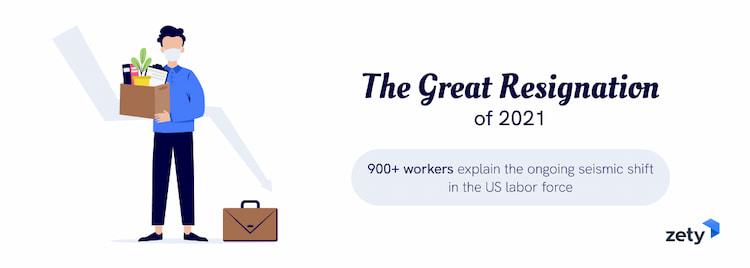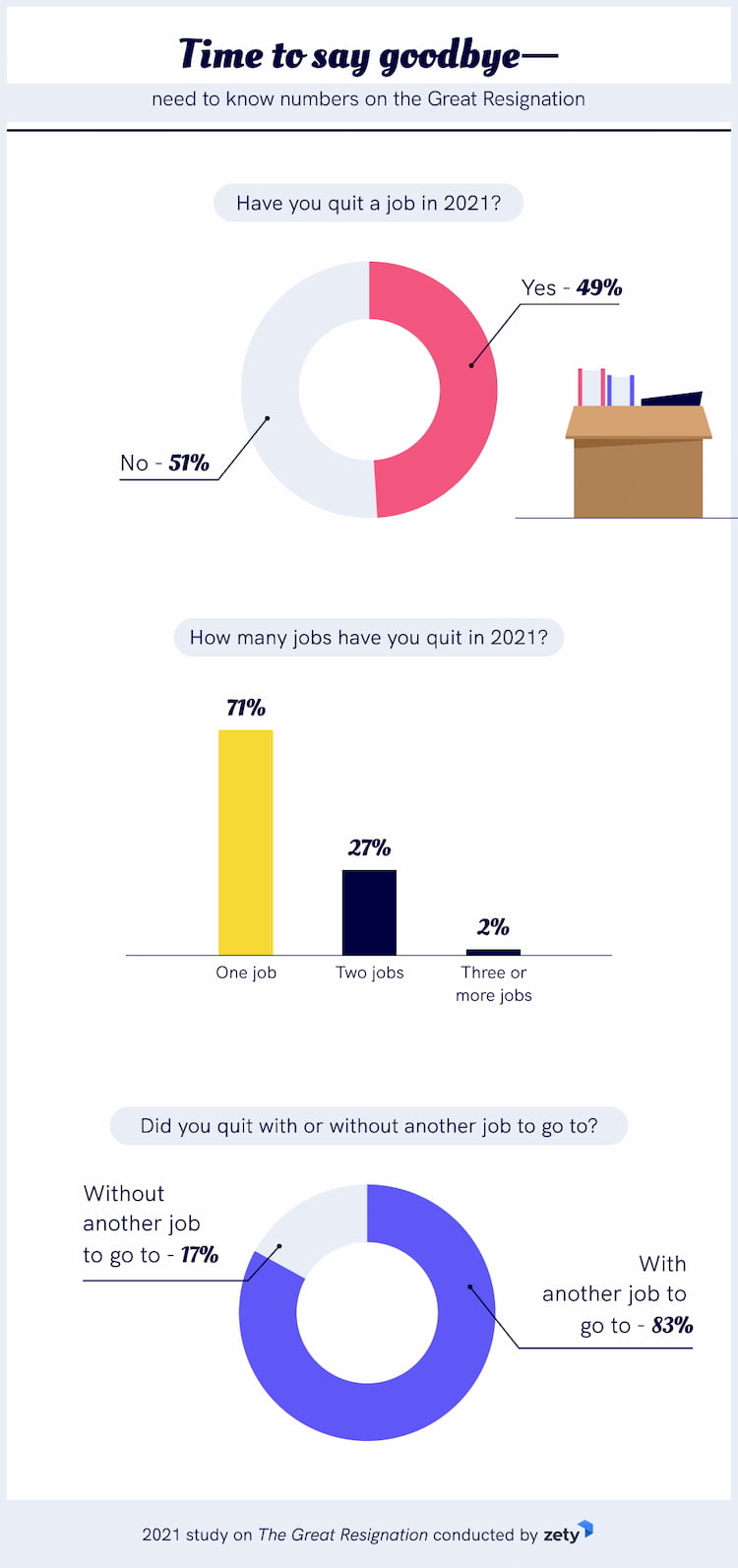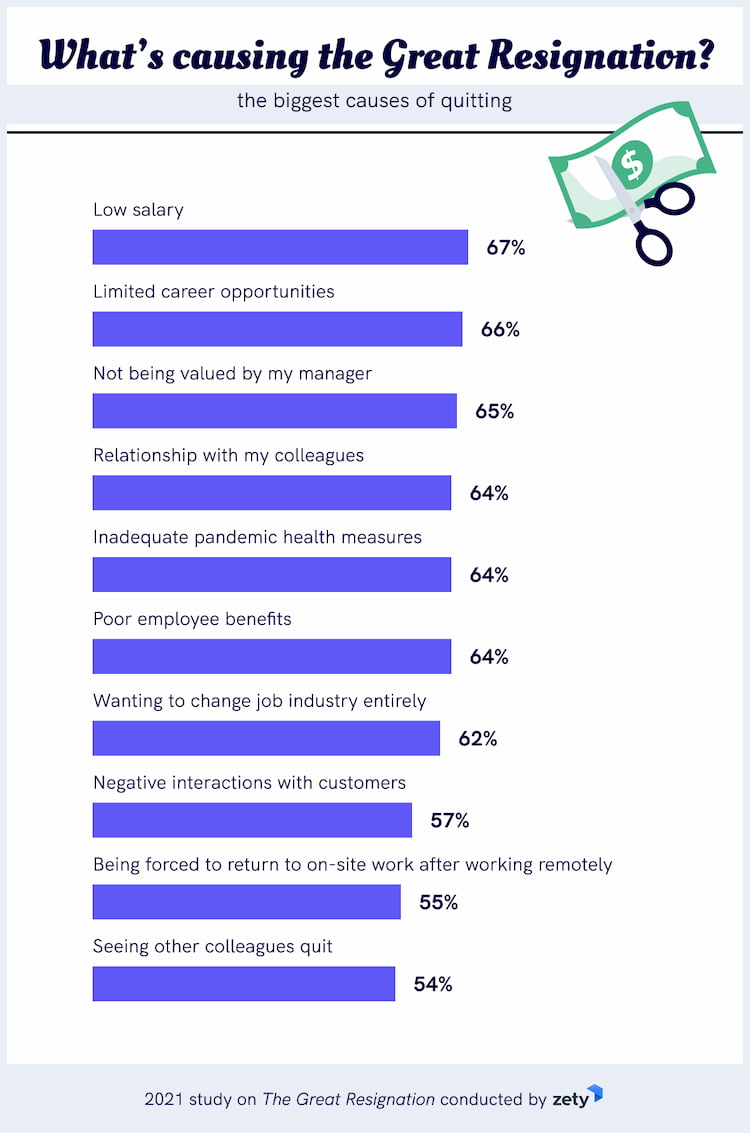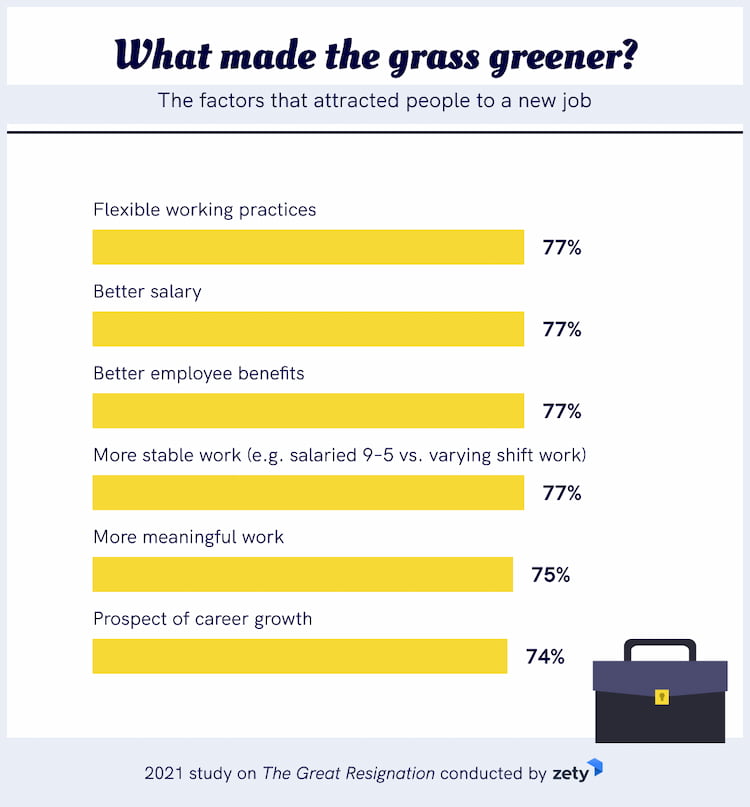
More Frightening Than Death: Fear & Loathing in Retirement
Many of us love to hate our jobs, but it turns out people don’t look forward to retirement as much as you might think. We explore why retiring is a frightening prospect.

Millions of workers across America are quitting their jobs in search of new opportunities. Find out their reasons, and what employers can do to stem the tide.

The Great Resignation. The Great Reshuffle. The Big Quit. Call it what you will, it’s become a hot topic and created untold challenges for employers.
In case you missed the memo, the Great Resignation refers to the unprecedented numbers of workers quitting their jobs. And it’s not just the latest media buzzword. The data confirms that employees really are throwing in the towel in record numbers.
The US Bureau of Labor Statistics measures the rate of resignation in the American labor force using a metric called non-farm quits. This hit 3% in September, the most recent month for which figures are available. That’s the highest ever recorded.
And it's the sixth straight month of record quits. Each month since April 2021 hitting a new high.
So the Great Resignation is real, and showing no signs of slowing. But what’s making so many workers pack their boxes and head for the door? And what can employers do to retain their valuable human capital?
Those are the questions we’ve sought to answer. We conducted a survey of 900+ American workers to get to the bottom of the Great Resignation of 2021. And we gained valuable insights into this fascinating period of change.
Before we reveal our findings, a little background on the Great Resignation. Anthony Klotz, a professor of management at Texas A&M coined the term and it began to gain traction in May 2021.
Back in 2020, resignation rates had fallen to the lowest levels in a decade. The fear and uncertainty created by the pandemic and associated shutdowns made people stay put.
But as they hunkered down, workers had the chance to reassess their relationship with work. The old ways of trudging back and forth to a daily grind were suddenly cast in a stark new light. Then, as the vaccination program picked up pace, by April 2021 the resignation trend had reversed, spiking sharply upwards.
And the number of people quitting is in the millions. In April 2021, a then record 4 million Americans said goodbye to their employers. Fast-forward to September, and 4.4 million quit in one month alone.
To put that in perspective, that’s the equivalent of the population of Los Angeles. Big numbers, but a little dry when taken in isolation. So let’s take a look at some stats taken from the folks who are driving the Great Resignation. The workers themselves.

The first thing that struck us is the sheer number of people who'd quit their jobs in 2021. Half of our respondents had resigned from a job this year with around a third of them having quit two or more times.
But that’s just the overall figure. Breaking it down demographically, we discovered some particularly interesting insights.
It’s become cliché to say that Millennials and Generation Z are set to transform the workplace, but numbers like this bring truth to the hype.
The youngest workers in particular aren’t willing to stay put in their jobs anymore. And the new world of hybrid teams, remote working and portfolio careers means it’s easier than ever to job-hop to your heart's content.
But despite this, there was still a degree of caution in this tidal wave of quits.
83% of our respondents quit when they had another job to go to. And that’s no surprise because there were plenty of jobs to apply for. Vacancies hit a record high in the summer, with 10.9 million openings posted in July alone.
And if you’re still not convinced about the sheer number of people calling it a day then consider this.
That’s roughly twice the entire population of Canada. So it’s fair to say that the great resignation has been a true tidal wave of quits.
And there’s plenty of discontent even amongst those who haven’t quit their jobs this year. 34% of people who haven’t resigned in 2021 are currently thinking about quitting.
And again, it’s the youngest workers who are most dissatisfied. 49% of the millennials in this group were thinking about quitting, vs. 29% of our oldest respondents.
Which raises the question. What’s driving this historical period of change in the workplace? Sure, there’s the black swan event of the pandemic, but what specific factors are making workers seek new opportunities? And what can employers learn from this?
That’s what we examined next.

The figures you’ve just seen represent the biggest considerations influencing those who quit their jobs in 2021. We gave our survey takers a list of factors and asked them to rate them in terms of importance in their decision to quit.
The numbers shown represent the percentage of respondents who ranked that factor as important or very important.
No prizes if you’d already guessed what the biggest cause of quitting was. Low pay continues to plague many industries. And lower-paid workers are showing a strong resolve to quit their jobs, regardless of the circumstances.
If we circle back to the numbers of respondents who quit without another job to go to, it was the lowest-paid cohort who were most willing to do so. 24% of those earning less than $25,000 a year were willing to leave a job without having another one lined up.
One example of this went viral when a group of Burger King restaurant staff in Nebraska quit en masse in July, putting up a sign that said:
“We all quit. Sorry for the inconvenience.”
And with increasing pressure from the Biden White House to push for a $15 minimum wage, it might just be that the tide is turning against underpaid work.
Other factors related to working conditions featured strongly. Limited career opportunities and poor employee benefits were both popular choices.
But it’s the number three spot that’s particularly interesting. Not being valued by your manager. This factor is nothing new. Time and again, research has shown that good employee engagement is strongly linked to having a good manager.
As far back as 2013, Gallup examined decades of data and found the following:
The people picked to be managers account for the majority of variance in almost all performance-related outcomes.
And an SHRM poll in 2020 revealed that 84% of workers blame bad managers for causing unnecessary stress.
Point being, organizations can’t just boost pay and employee benefits. They’ve got to ensure they’ve got the right people in leadership positions, too.
Another important factor we encountered was “negative interactions with customers.”
We’re all familiar with the “Karen” stereotype, and customer horror stories often go viral due to their sheer awfulness. But bad customer behavior isn’t just internet fodder. It’s tipping underpaid, underappreciated workers over the edge.
And again, this bump in bad behavior isn’t just speculation or a case of workers being oversensitive. It’s backed up by data, too. In just one example, the FAA reports a massive increase in the number of unruly passenger investigations.
In 2019, there were 146 investigations, but in 2021 that skyrocketed to 973. People really are behaving more badly it seems.
We expected that being forced to return to onsite work would feature higher up on our list. But that’s not to say it’s insignificant. With more than half of our respondents rating it as important, we wouldn’t recommend declaring a victory for 9–5 cubicle dwelling.
As with all of our findings, we took a deep dive into the differences between demographics, but here there really wasn’t a lot to report on. The things that made people quit were pretty universal across gender, age groups, and industries.
Interestingly, even low pay remained a constant. Employees earning $75,000+ annually ranked it just as significant a factor as those earning less than $25,000. Though perhaps the inflation rate is having an influence here.
We ran this survey just as US inflation shot past 6%, its highest rate in decades. So everyone’s dollar is worth less.
Next, if you’re an employer looking to stop your bleed of talent, you might want to pay attention to the next set of findings.
To refine our understanding, we sought to discover what’s driving workers who are still at their desks, but thinking of quitting. It’s one thing to use hindsight to explain losses, but prevention is better than cure.

We gave this group the same set of influencing factors as workers who said they’d quit. But a few interesting differences emerged when it came to how they were ranked.
Low pay became the overwhelming favorite here, with 80% citing it as an important factor in thinking of quitting.
Seeing other colleagues quit came dead last, same as the previous set of data, but here it was a clear minority of workers who said it was important. Quitting can be contagious, but it’s hardly the biggest force at play here.
So—
How can employers stop workers from quitting?
Covering those points won’t guarantee a completely stable workforce. The days of 40 years in the same company and a gold watch on retirement day are long gone. But responding to those needs will help to address preventable losses.
But what about taking it to the next level. What can an employer do to keep their existing talent and attract fresh blood from companies who aren’t adjusting to the new employment normal?
Here we asked workers who’d quit their jobs and moved onto a new employer what it was that attracted them to their new gig.
Spoiler. It wasn’t free ice-cream.

Four factors tied for the number one spot.
And again these factors stayed consistent when we took different demographics into account.
We found agreement on another very important point too.
Our final finding should serve as a word of warning to any employer tempted to treat the Great Resignation as an aberration.
That figure rose to 91% for respondents with no college degree. So it appears that the people who’ve suffered the most on the bottom rung of the labor force are the most eager to keep the spirit of the Big Quit alive.
The Great Resignation may have been triggered by the events of 2020, but the underlying causes are old problems. Employees just aren’t as willing to tolerate them as they used to be.
Organizations who want to retain existing employees and attract new ones have a number of key points to address.
In a world where workers are more willing than ever to quit, paying low salaries and cutting back on benefits is a false economy.
It’s not just the fact that employers will struggle to hire and retain. Every time an employee leaves, the bottom line takes a big hit.
Here’s why. The cost of replacing an employee is anywhere between 50% and 200% of their salary. Now let’s imagine a company of 100 employees, with a turnover rate of 10%, where everyone earns the national average salary of around $56,000 per year. And we’ll assume the replacement cost is 100%.
Let’s do the math. Ten employees leave, the cost of replacing them is 100% of their salary. That’s 10 times $56,000, coming to a cost of $560,000. More than half a million lost due to turnover.
And that’s a lowball figure that doesn’t take into account the increased turnover rate of the Great Resignation. Failing to act could be financially crippling.
Some industries can’t function without having employees on-site. We acknowledge it’s not practical for everyone to work remotely. And some face-to-face collaboration has clear benefits.
But where hybrid working is possible, employers need to implement it to retain their talent.
Flexible working was on top of the list of factors that attracted our respondents to a new job, and employers that don’t offer it risk being left behind.
Poor leadership is toxic to an organization. We’ve long known the risks posed by bad management, but workers simply won’t tolerate it anymore. Organizations should ensure their leaders have the skills needed to keep talent on board.
Giving employees opportunities for advancement and development is a no-brainer in an age of high turnover. It was a top factor for our respondents, both in making people actually quit and making them think of quitting.
And unsurprisingly, career advancement is a big consideration for people just starting out in the world of work. Young people cited it as one of the top three reasons they’d consider quitting in a recent study we conducted on Generation Z and the workplace.
To conclude, we’ll say it again. The relationship between employers and employees is undergoing a revolutionary change, and there’s no sign of it stopping.
A constant bleed of talent and lack of human resource isn’t sustainable. But making some simple changes will help employers hold onto existing staff, and poach new talent from organizations that don’t wake up and smell the coffee.
Methodology
The findings presented were obtained by surveying 980 American respondents. They were asked questions relating to their experiences of the Great Resignation. These included yes/no questions, scale-based questions relating to levels of agreement with a statement, questions that permitted the selection of multiple options from a list of potential answers, and a question that permitted open responses.
Want to share our content to help people learn more about the Great Resignation? We’d love you to. All we ask is that you link back to this page, giving full credit to our authors. After all, we don’t want them to quit.
Zety’s free resume builder uses the best resume templates to help job seekers, regardless of their profession or job title. Our specialist guides can even help candidates write a resume with no work experience.
Many of us love to hate our jobs, but it turns out people don’t look forward to retirement as much as you might think. We explore why retiring is a frightening prospect.
We’ve extracted and analyzed data from 670,000+ resumes to find out the most common practices and ways you can use them to boost your job search.
We took the pulse of over 200 US Gen Zers to uncover what they expect from employers, their attitudes toward work, and more.

![Generation Z vs. The Workplace [2021 Study]](https://cdn-images.zety.com/pages/generation_z_vs_workplace_7.jpg?fit=crop&h=250&dpr=2)